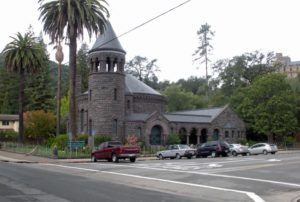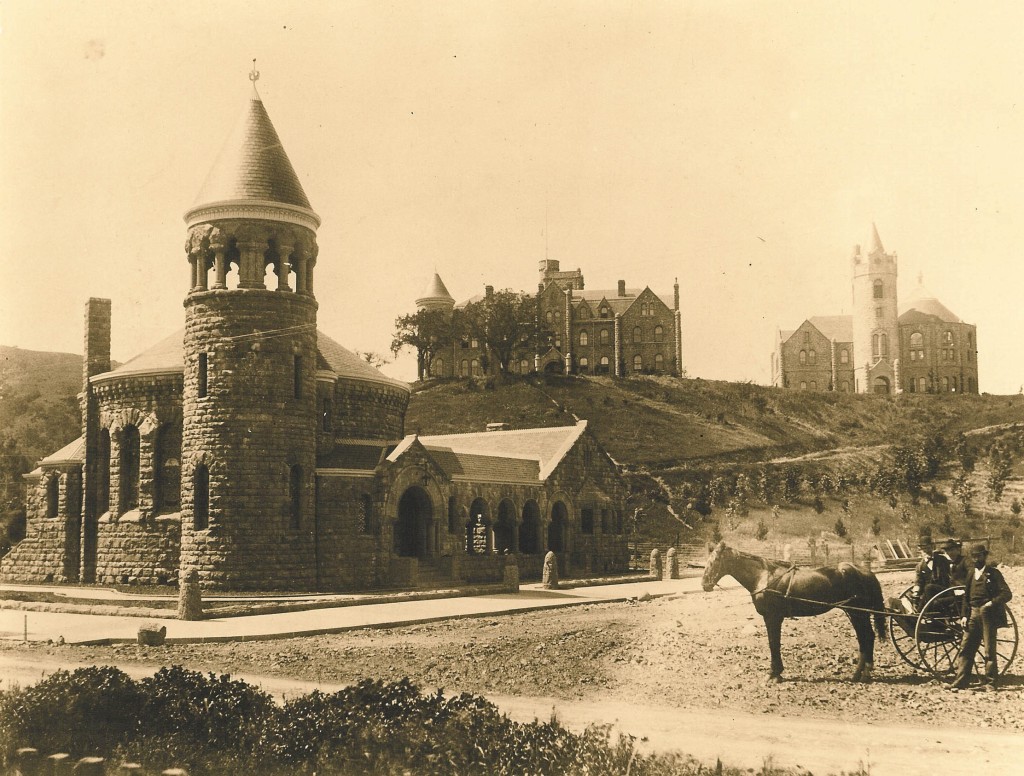
Montgomery Chapel, 2011
The cornerstone for Montgomery Memorial Chapel, at the corner of Richmond Road and Bolinas Avenue on the grounds of San Francisco Theological Seminary, was laid on April 26, 1894. The chapel was completed three years later.
It is an anomaly in that it is the mausoleum of Alexander Montgomery, a Mason, and at the same time a chapel of a religious denomination to which Montgomery did not belong.
Montgomery was born in 1825 in Northern Ireland. As a young boy, he was apprenticed as a tailor, a trade he pursued when he arrived in New York in 1846. The news of the gold discovery lured him to California in 1849. Unsuccessful at mining, Montgomery tried various other enterprises before making substantial sums lending money to farmers in Colusa and Tehama counties. By the time he moved to the Bay Area and opened an office in San Francisco in the early 1880s, he was a very wealthy man. More about Alexander Montgomery’s colorful personal life and clouded past – his forced marriage at gun point to a woman 35 years his junior and the mother of his two children – can be found here.
Montgomery was one of the Seminary’s most important benefactors even though he was not a Presbyterian, except through his Scottish ancestry, or a religious man. His generous contribution of $250,000 in 1889 and another $10,000 in 1891 enabled the Seminary to begin development of the San Anselmo campus with the construction of Montgomery and Scott Halls and faculty houses.
Shortly before his death in November 1893, Montgomery executed his will which provided an additional $50,000 to the Seminary for the construction and maintenance of a monument in which he was to be interred. When he died he was buried at Laurel Hill Cemetery in San Francisco and his remains were moved to Montgomery Chapel just days before its 1897 dedication.
Like Montgomery and Scott Halls on the hill above, the chapel was designed by John Wright of the San Francisco architectural firm of Wright & Sanders in the Richardsonian Romanesque style. William Barr of San Rafael was the carpenter and the stone was quarried in Sonoma County.
Inside there is a circular sanctuary with Montgomery’s crypt to the left of the entrance in an alcove with the tower rising above. A life-size Carrara marble bust of Montgomery is mounted there. It was carved by Rupert Schmid, a noted sculptor of the day. The sanctuary’s special characteristics create a sort of stereophonic effect if one stands in a central spot and speaks in a normal voice.
John Wright’s masterful design incorporated a private Masonic mausoleum with a public Presbyterian chapel. The interior is devoid of Christian images, but rich in Masonic symbols. The beautiful stained glass windows depict passages from the Old Testament.
Upon completion, Montgomery Chapel was used by the Presbyterian Church of San Anselmo as its sanctuary for 61 years. It was also used by Greek Orthodox and Jewish congregations.
A $3 million restoration was completed in 1995. Fundraising was led by great-grandchildren of Alexander Montgomery. The chapel annex is named Montague Hall in honor of Montgomery Montague, Sr., Alexander Montgomery’s grandson.
Today, the chapel is used primarily to train seminarians for their ministries, offering two chapel services a week. It is a popular site for weddings, bar and bat mitzvahs and concerts.


